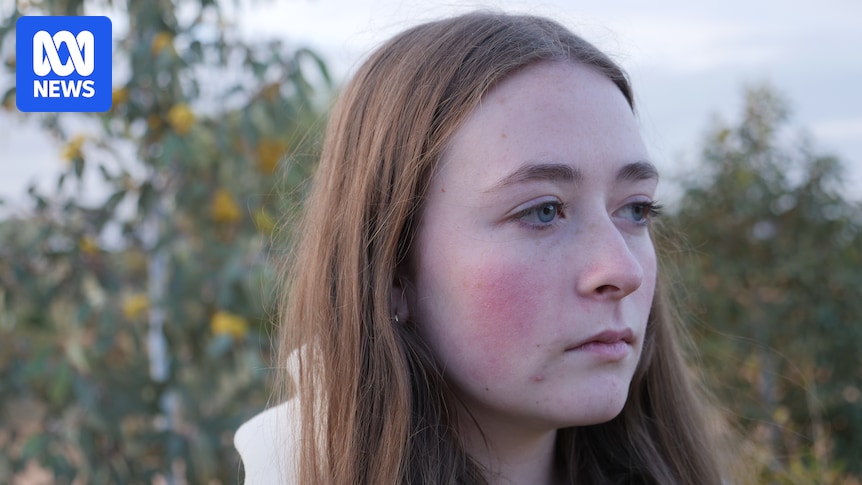The night 14-year-old Tess Hansen thought she was having a heart attack and sought emergency medical help, she was asked if she was having “boy problems”.
The Riverland teen had a heartbeat of 190bpm, had been experiencing vertigo, body aches, and chronic fatigue, and had recently been diagnosed with postural orthostatic tachycardia syndrome (POTS).
But no-one outside her family would take her illness seriously — an issue common among Australians with the condition.
Tess has missed more than 10 weeks of school this year alone and had to drop subjects, meaning she is no longer eligible for an ATAR. (ABC Riverland: Sophie Landau)
The first time Tess saw a doctor about her symptoms before her heart scare, she was told it was just a virus — a diagnosis her mother Lily said was not reflective of the range of severe symptoms she was seeing.
“She couldn’t even lift her head into a sitting position let alone a standing position,” Ms Hansen said.
“I didn’t know one week in bed would turn into 10.”
Weeks and months went by and still Tess was not recovering.
Desperate for answers, Ms Hansen searched far and wide for help.
Lily Hansen says if she knew about POTS early on, she would not have pushed Tess to keep going. (ABC Riverland: Sophie Landau)
Eventually, after 18 long months, during an unrelated specialist appointment, a cardiologist suggested Tess should be tested for POTS.
Within 10 minutes, Tess was diagnosed.
“We were like: ‘What? What is this?'” Ms Hansen recalled.
What is POTS?
POTS is the most common form of dysautonomia, a disorder that stops the autonomic nervous system from working properly and affects the heart rate, blood pressure, respiration, and digestion.
The poorly recognised condition has most commonly been linked to viral infections like COVID-19 and its symptoms include dizziness, heart palpitations, fatigue, nausea, and brain fog.
The debilitating condition is also five times more likely to affect young women than men.
Leading cardiologist and POTS researcher Dennis Lau said the test for POTS was a simple 10-minute lie-down, stand-up assessment where a doctor measures the heart rate against the blood pressure at five-minute set intervals.
Dr Dennis Lau says doctors do not know enough about POTS. (ABC News: Justin Hewitson)
Medical gaslighting
As Ms Hansen and her family experienced, the road to diagnosis is long and fraught.
Dr Lau said POTS was not being taught about properly in Australian medicine.
“Because dysfunction of the autonomic nervous system isn’t properly taught in medical school, many people with dysautonomia are misdiagnosed or neglected, and often they’re told nothing is wrong with them,” Dr Lau said.
Even after being diagnosed with POTS, Tess said, on many occasions, doctors told her she needed to “seek therapy for anxiety”.
“I’ve had doctors who have said: ‘You tell me what you need because I don’t know anything about this condition’,” she said.
Since being diagnosed, Tess studies from the couch to combat extreme fatigue. (ABC Riverland: Sophie Landau)
Australia behind the eight ball
Celine Gallagher, a senior research fellow with the Australian Dysautonomia and Arrhythmia Research Collaborative, has diagnosed 600 patients in South Australia since 2021, working alongside the University of Adelaide at a private clinic that specialises in POTS.
Dr Gallagher says Australia is behind the rest of the world when it comes to diagnosing POTS. (Supplied)
The clinic has assessed more than 1,700 people for symptoms that are consistent with POTS and started a patient registry of everyone diagnosed.
“Our POTS patient registry is the only one in the Southern Hemisphere,” Dr Gallagher said.
In Australia, POTS does not have a unique international classification of disease code (ICD), meaning there is no official tracking of the disease and how many people it impacts.
The first public POTS clinic is at the Royal Adelaide Hospital. (ABC News: Michael Clements)
“Seventy-nine per cent of people with long COVID meet criteria for POTS and this has serious implications for the way we look to diagnose and assess people with long COVID,” Dr Gallagher said.
As part of her role with the Australian POTS Foundation, Dr Gallagher has assisted in opening access to public patients experiencing POTS symptoms, including the opening of the first public POTS clinic at the Royal Adelaide Hospital.
The clinic opened just over five months ago and already has a 15-month waiting list.
South Australian epidemiologist Adrian Esterman has been invited to speak to a select committee in Parliament to brief them on the current state of COVID-19 in the state.
Professor Esterman says the state government should be doing more to support patients with long COVID. (ABC News: Justin Hewitson)
Professor Esterman said the state government should open more health clinics for those experiencing post-infection disorders such as POTS.
“If you think about it, there have been over a million cases of COVID-19 in South Australia alone,” he said.
“We know that there are approximately 35,000 South Australians with long COVID — at least that many — and what concerns me is we have very few services available to treat it.”
In a statement, SA Health said: “Waiting list times are triaged according to priority need based on information provided in referrals [and] not all patients with long COVID symptoms require the level of care provided through a long COVID clinic.”
Future remains uncertain
Ms Hansen said the impact of Tess’s POTS diagnosis and the hurdles they have had to overcome have impacted the whole family.
“There is a knock-on effect — I get fatigued, my husband gets fatigued, my other daughter worries,” Ms Hansen said.
“Tess can no longer drive. She can’t work.
“Working one shift on a Sunday could mean she’s in bed for two weeks.”
Tess says having a fitness plan and performing horizontal exercises like rowing have been part of her POTS management journey. (ABC Riverland: Sophie Landau)
Now ineligible for an ATAR from missing too much school, Tess is focused on building her strength so she can live life to the fullest.
“I feel like this past year we’ve progressed a lot with what we’ve discovered … but I think there are certainly a lot more rough patches to go through,” she said.
“Obviously, I wish for [my POTS] to be gone, but I just hope we can continue to manage it a lot better going into the future.”




